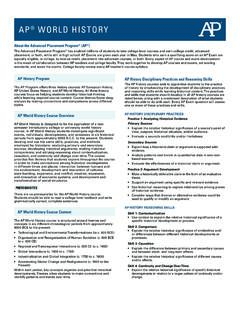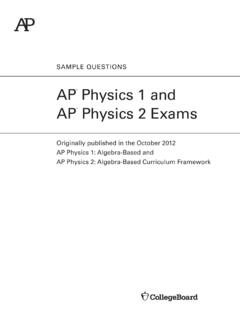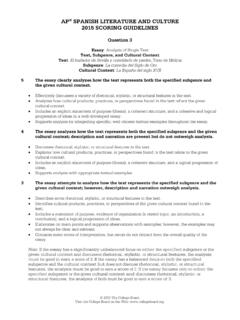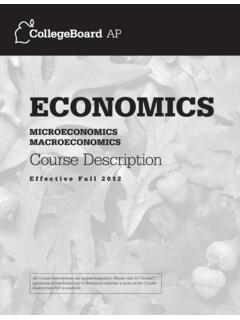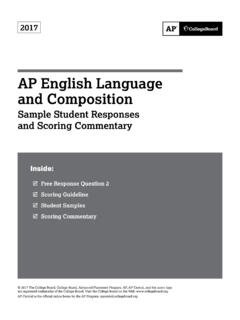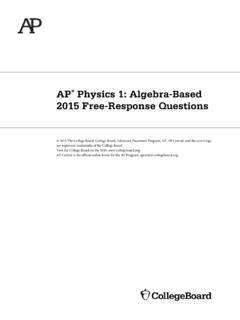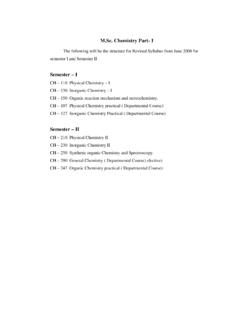Transcription of AP Chemistry 2018 Free-Response Questions
1 2018. AP Chemistry Free-Response Questions 2018 The College Board. College Board, Advanced Placement Program, AP, AP Central, and the acorn logo are registered trademarks of the College Board. Visit the College Board on the Web: AP Central is the official online home for the AP Program: -2- AP Chemistry EQUATIONS AND CONSTANTS. Throughout the exam the following symbols have the definitions specified unless otherwise noted. L, mL = liter(s), milliliter(s) mm Hg = millimeters of mercury g = gram(s) J, kJ = joule(s), kilojoule(s). nm = nanometer(s) V = volt(s). atm = atmosphere(s) mol = mole(s). ATOMIC STRUCTURE. E = energy E = h = frequency c = = wavelength Planck's constant, h = 10 34 J s Speed of light, c = 108 m s 1. Avogadro's number = 1023 mol 1. Electron charge, e = 10 19 coulomb EQUILIBRIUM. [C]c [D]d Kc = , where a A + b B R c C + d D Equilibrium Constants [A]a [B]b Kc (molar concentrations).
2 (PC )c (PD )d Kp = Kp (gas pressures). (PA )a (PB )b Ka (weak acid).. Ka = [H ][A ] Kb (weak base). [HA] Kw (water).. Kb = [OH ][HB ]. [B]. Kw = [H ][OH ] = 10 14 at 25 C. +. = Ka K b pH = log[H+] , pOH = log[OH ]. 14 = pH + pOH.. pH = pKa + log [A ]. [HA]. pKa = logKa , pKb = logKb KINETICS. ln[A] t ln[A] 0 = kt k = rate constant t = time 1 1 = kt t = half-life >A @t >A t = k -3- GASES, LIQUIDS, AND SOLUTIONS. P = pressure V = volume PV = nRT. T = temperature moles A n = number of moles PA = Ptotal XA, where XA =. total moles m = mass Ptotal = PA + PB + PC + .. M = molar mass D = density n = m KE = kinetic energy M. v = velocity K = C + 273. A = absorbance D= m a = molar absorptivity V. b = path length KE per molecule = 1 mv 2 c = concentration 2. Molarity, M = moles of solute per liter of solution Gas constant, R = J mol 1 K 1. A = abc = L atm mol 1 K 1.
3 = L torr mol 1 K 1. 1 atm = 760 mm Hg = 760 torr STP = K and atm Ideal gas at STP = L mol 1. THERMODYNAMICS / ELECTROCHEMISTRY. q = heat q = mc T m= mass c = specific heat capacity S = SD products SD reactants T= temperature S = standard entropy H = DHfD products DHfD reactants H = standard enthalpy G = standard Gibbs free energy G = DGfD products DGfD reactants n = number of moles E = standard reduction potential G = H T S I = current (amperes). = RT ln K q = charge (coulombs). = n E t = time (seconds). q Faraday's constant, = 96,485 coulombs per mole I =. t of electrons 1 joule 1 volt =. 1 coulomb -4- 2018 AP Chemistry Free-Response Questions . Chemistry . Section II. Time 1 hour and 45 minutes 7 Questions YOU MAY USE YOUR CALCULATOR FOR THIS SECTION. Directions: Questions 1 3 are long Free-Response Questions that require about 23 minutes each to answer and are worth 10 points each.
4 Questions 4 7 are short Free-Response Questions that require about 9 minutes each to answer and are worth 4 points each. Write your response in the space provided following each question. Examples and equations may be included in your responses where appropriate. For calculations, clearly show the method used and the steps involved in arriving at your answers. You must show your work to receive credit for your answer. Pay attention to significant figures. Na2S2O3(aq) + 4 NaOCl(aq) + 2 NaOH(aq) 2 Na2SO4(aq) + 4 NaCl(aq) + H2O(l). D , for the 1. A student performs an experiment to determine the value of the enthalpy change, DHrxn oxidation-reduction reaction represented by the balanced equation above. (a) Determine the oxidation number of Cl in NaOCl. (b) Calculate the number of grams of Na2S2O3 needed to prepare mL of M Na2S2O3(aq).
5 In the experiment, the student uses the solutions shown in the table below. Concentration Volume Solution (M) (mL). Na2S2O3(aq) NaOCl(aq) NaOH(aq) (c) Using the balanced equation for the oxidation-reduction reaction and the information in the table above, determine which reactant is the limiting reactant. Justify your answer. 2018 The College Board. Visit the College Board on the Web: GO ON TO THE NEXT PAGE. -5- 2018 AP Chemistry Free-Response Questions . The solutions, all originally at C, are combined in an insulated calorimeter. The temperature of the reaction mixture is monitored, as shown in the graph below. (d) According to the graph, what is the temperature change of the reaction mixture? (e) The mass of the reaction mixture inside the calorimeter is g. (i) Calculate the magnitude of the heat energy, in joules, that is released during the reaction.
6 Assume that the specific heat of the reaction mixture is J/(g C) and that the heat absorbed by the calorimeter is negligible. (ii) Using the balanced equation for the oxidation-reduction reaction and your answer to part (c), calculate the value of the enthalpy change of the reaction, DH D , in kJ/mol . Include the appropriate algebraic rxn rxn sign with your answer. The student repeats the experiment, but this time doubling the volume of each of the reactants, as shown in the table below. Concentration Volume Solution (M) (mL). Na2S2O3(aq) NaOCl(aq) NaOH(aq) (f) The magnitude of the enthalpy change, DHrxn D , in kJ/mol , calculated from the results of the second rxn experiment is the same as the result calculated in part (e)(ii). Explain this result. (g) Write the balanced net ionic equation for the given reaction. 2018 The College Board.
7 Visit the College Board on the Web: GO ON TO THE NEXT PAGE. -6- 2018 AP Chemistry Free-Response Questions . 2 NO(g) + O2(g) 2 NO2(g). 2. A student investigates the reactions of nitrogen oxides. One of the reactions in the investigation requires an equimolar mixture of NO(g) and NO2(g), which the student produces by using the reaction represented above. (a) The particle-level representation of the equimolar mixture of NO(g) and NO2(g) in the flask at the completion of the reaction between NO(g) and O2(g) is shown below in the box on the right. In the box below on the left, draw the particle-level representation of the reactant mixture of NO(g) and O2(g) that would yield the product mixture shown in the box on the right. In your drawing, represent oxygen atoms and nitrogen atoms as indicated below. The student reads in a reference text that NO(g) and NO2(g) will react as represented by the equation below.
8 Thermodynamic data for the reaction are given in the table below the equation. NO(g) + NO2(g) R N2O3(g). D. DH D. DS D. DG . kJ/molrxn J/(K molrxn) kJ/molrxn (b) The student begins with an equimolar mixture of NO(g) and NO2(g) in a rigid reaction vessel and the mixture reaches equilibrium at 298 K. (i) Calculate the value of the equilibrium constant, K, for the reaction at 298 K. (ii) If both PNO and PNO 2 in the vessel are initially atm, will PN 2O 3 at equilibrium be equal to atm? Justify your answer. (c) The student hypothesizes that increasing the temperature will increase the amount of N2O3(g) in the equilibrium mixture. Indicate whether you agree or disagree with the hypothesis. Justify your answer. 2018 The College Board. Visit the College Board on the Web: GO ON TO THE NEXT PAGE. -7- 2018 AP Chemistry Free-Response Questions .
9 N2O3(g) reacts with water to form nitrous acid, HNO2 (aq), a compound involved in the production of acid rain. The reaction is represented below. N2O3(g) + H2O(l) 2 HNO2(aq). (d) The skeletal structure of the HNO2 molecule is shown in the box below. (i) Complete the Lewis electron-dot diagram of the HNO2 molecule in the box below, including any lone pairs of electrons. H O N O. (ii) Based on your completed diagram above, identify the hybridization of the nitrogen atom in the HNO2. molecule. To produce an aqueous solution of HNO2 , the student bubbles N2O3(g) into distilled water. Assume that the reaction goes to completion and that HNO2 is the only species produced. To determine the concentration of HNO2(aq) in the resulting solution, the student titrates a 100. mL sample of the solution with M KOH(aq). The neutralization reaction is represented below.
10 HNO2(aq) + OH (aq) NO2 (aq) + H2O(l). The following titration curve shows the change in pH of the solution during the titration. (e) Use the titration curve and the information above to (i) determine the initial concentration of the HNO2(aq) solution (ii) estimate the value of pKa for HNO2(aq). (f) During the titration, after a volume of 15 mL of M KOH(aq) has been added, which species, HNO2(aq) or NO2 (aq), is present at a higher concentration in the solution? Justify your answer. 2018 The College Board. Visit the College Board on the Web: GO ON TO THE NEXT PAGE. -8- 2018 AP Chemistry Free-Response Questions . 3. Answer the following Questions relating to Fe and its ions, Fe2+ and Fe3+. (a) Write the ground-state electron configuration of the Fe2+ ion. Ion Ionic Radius (pm). Fe2+ 92. Fe3+ 79. (b) The radii of the ions are given in the table above.
